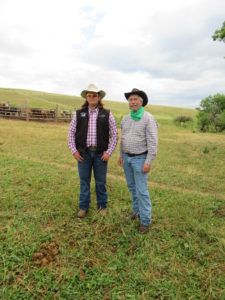 While planning our trip to the TX Ranch, in Montana, I experienced difficulty explaining it to other people. Part of the problem was I had never actually visited the TX Ranch, myself. My expectations were based on second-hand information through friends and websites. The bigger problem, though, was in trying to explain the unique experience offered by the TX Ranch.
While planning our trip to the TX Ranch, in Montana, I experienced difficulty explaining it to other people. Part of the problem was I had never actually visited the TX Ranch, myself. My expectations were based on second-hand information through friends and websites. The bigger problem, though, was in trying to explain the unique experience offered by the TX Ranch.
“Dawson and I are planning a trip to a cattle ranch in Montana, where we will spend a full week working cattle from horseback,” I would say.
This was typically met with a response such as, “Oh, like the movie, City Slickers!”
“Well… sort of… except hopefully a bit less touristy and a bit more real commercial working cattle ranch.”
“So, like a dude ranch?”
“No, not really. I mean, yeah, it is a ranch with paying guests. However, dude ranch usually means sleeping in air-conditioned cabins and going on guided trail rides. That’s not what this ranch is about.”
So… having just experienced my first visit to the TX Ranch, I will try to describe what it is like.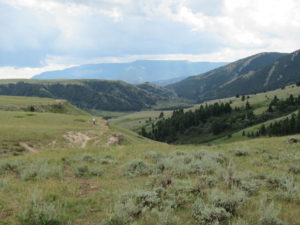
The TX Ranch is located deep in the Pryor Mountains of southern Montana and northern Wyoming. I had understood it to be located about a two-hour drive south of Billings. I did not realize a full hour of that drive is off paved roads, mostly on pasture tracks winding back through the mountain meadows, up and down steep grades, crossing creeks in deep gullies, and stopping every mile or so to open and close gates.
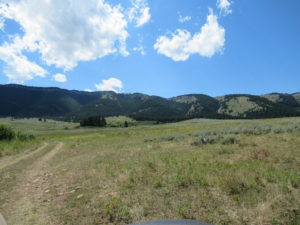 The scenery is stunning. Each curve and hill reveals yet another scenic panorama of soaring mountains slashed by deep ravines and steep valleys. The spectacular Pryor Mountain scenery is a continual backdrop to every activity at the ranch.
The scenery is stunning. Each curve and hill reveals yet another scenic panorama of soaring mountains slashed by deep ravines and steep valleys. The spectacular Pryor Mountain scenery is a continual backdrop to every activity at the ranch.
The camp accommodations are quite rustic. We slept on cots in tents. We had no electricity or internet access. Our only water supply was from a nearby mountain spring with a gravity-fed water line directing water into a plastic tank for our use. Toilets consisted of outhouses. Showers were accomplished via camp shower bags, whose temperature depended on the amount of sunshine on a given day.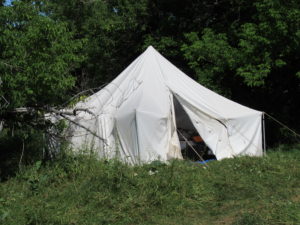
The kitchen and dining hall are in a log cabin lighted by Coleman lanterns. Meals are prepared on a gas stove fueled by propane bottles of an appropriate size to haul in the back of a pickup truck.
Overall, the accommodations are what one might expect at a working cow camp… which is exactly what this is. That should be the first clue 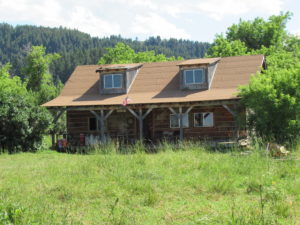 as to what the week was like.
as to what the week was like.
We all signed on to spend a week experiencing the life of a historic western cowboy and the TX Ranch did not disappoint. The owner, Hip, treated us like the latest group of newly hired employees. Each morning after breakfast and saddling horses, Hip discussed the plans for the day. Then we would split into smaller groups assigned to different areas and ride out to gather cattle.
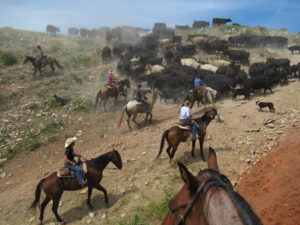 The first day, we gathered cattle out near the horse pasture and pushed them to a hilltop where they were easy to hold. There we roped, ear tagged, castrated, and inoculated the calves.
The first day, we gathered cattle out near the horse pasture and pushed them to a hilltop where they were easy to hold. There we roped, ear tagged, castrated, and inoculated the calves.
The second day, we wrangled horses across a 15 mile drive through rugged country to the Deadman Camp in preparation for the following day.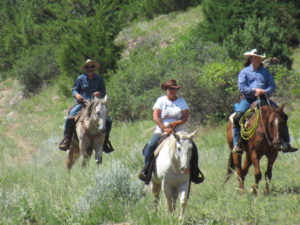
The third day, we were dropped off at Deadman, where we each saddled a fresh horse (because our first horse had been ridden hard for two days in a row). We then proceeded to gather cows from the Deadman area to drive back to a pasture closer to our camp at Lone Wolf. That was a long, hard, dusty workday. We worked 12 hours, with 11 hours in the saddle, gathering cows in mountainous terrain with dense brush filling the draws and creek banks.
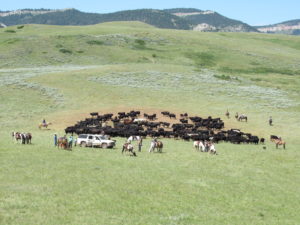 On the ride back, we paused at each gate to cut the herd, making sure only TX-owned cattle passed through the gate. I really enjoyed watching Hip and his daughter Des cut the herd. They were amazing! They each sized up at a glance which cows belonged. Then, with a subtle side-step of their horse to leave an opening while applying light pressure, they would signal three or four cows to abandon the herd and walk away. A slight shift the other direction and another cow walked off. It was truly poetry in motion watching the two of them work together to cut out all cattle not belonging to the TX herd.
On the ride back, we paused at each gate to cut the herd, making sure only TX-owned cattle passed through the gate. I really enjoyed watching Hip and his daughter Des cut the herd. They were amazing! They each sized up at a glance which cows belonged. Then, with a subtle side-step of their horse to leave an opening while applying light pressure, they would signal three or four cows to abandon the herd and walk away. A slight shift the other direction and another cow walked off. It was truly poetry in motion watching the two of them work together to cut out all cattle not belonging to the TX herd.
The fourth day, we made another gather of cattle near Star Hill, including those we brought back from Deadman the previous day. Then we roped, branded, ear-tagged, castrated, and inoculated the calves.
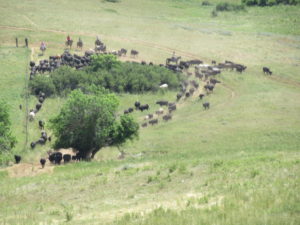 The fifth day, we gathered cows near the Lone Wolf Camp and nearby pastures and creeks. We used the Lone Wolf corrals to sort out all the calves, then cut the calves to only those who were not ear tagged. Then we worked the calves in the corral, which allowed everyone who wanted an opportunity to rope calves from the ground, without the added stress of managing reins and handling a horse while dallying to the saddle horn.
The fifth day, we gathered cows near the Lone Wolf Camp and nearby pastures and creeks. We used the Lone Wolf corrals to sort out all the calves, then cut the calves to only those who were not ear tagged. Then we worked the calves in the corral, which allowed everyone who wanted an opportunity to rope calves from the ground, without the added stress of managing reins and handling a horse while dallying to the saddle horn.
The sixth day was another gather, followed by working the calves, followed by moving the herd north to another pasture.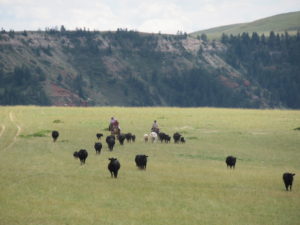
In six days, I rode four different horses. Each horse was a solid mount willing to ride up steep hills, down into deep ravines, and through thick brush to flush out cattle. Each horse worked hard all day, with enough energy to finish out the day pushing, holding or roping cattle.
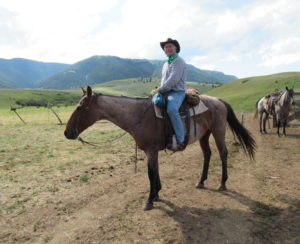 Some days included a lot of dismounting and remounting to stoop down walking thru the thick brush to flush cows out. I learned to always position the horse with the off side downhill for easier dismounting and remounting. All the horses ground-tied fairly well. My preferred mount, 773, stayed exactly where I dropped his reins, while I ran yelling thru the brush to flush cows. He then stood patiently while I returned to remount and ride off through thick brush to push the cattle into the growing herd.
Some days included a lot of dismounting and remounting to stoop down walking thru the thick brush to flush cows out. I learned to always position the horse with the off side downhill for easier dismounting and remounting. All the horses ground-tied fairly well. My preferred mount, 773, stayed exactly where I dropped his reins, while I ran yelling thru the brush to flush cows. He then stood patiently while I returned to remount and ride off through thick brush to push the cattle into the growing herd.
I learned to ride with split reins… something I previously never felt comfortable doing. A week of riding with split reins taught me they are no big deal. Plus, they come in pretty handy for swatting a contrary cow on the rump.
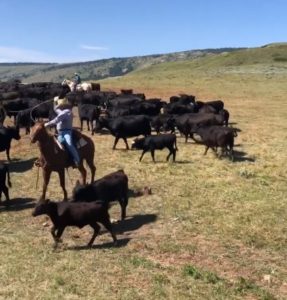 The first day, when Hip asked for volunteers to rope, I volunteered. As a result, I was part of the roping team for the remainder of the week. Although I was not very proficient, I did manage to rope about fifteen calves across the week.
The first day, when Hip asked for volunteers to rope, I volunteered. As a result, I was part of the roping team for the remainder of the week. Although I was not very proficient, I did manage to rope about fifteen calves across the week.
Those of you who have been tracking my personal story will recall learning to rope has been a goal of mine for a few years, now… since before cancer surgery took a major nerve in my right shoulder… limiting both strength and motion in that shoulder… as well as loss of muscle memory. So… bear with me as I do my happy dance for a moment.
I roped calves!!! Live calves… from horseback!!! 🙂
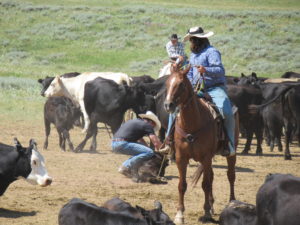 Dawson also roped… much more proficiently than I did. In fact, Dawson was pretty much our top roper. His experience competitively roping in the arena definitely proved useful. However, he learned roping in the middle of a herd is a lot different from competitive arena roping.
Dawson also roped… much more proficiently than I did. In fact, Dawson was pretty much our top roper. His experience competitively roping in the arena definitely proved useful. However, he learned roping in the middle of a herd is a lot different from competitive arena roping.
I also gained confidence trotting, loping, and galloping across all sorts of rough terrain. While gathering cattle, it was easy to forget to worry about my balance or the horse’s response, as both the horse and I focused on getting the job done.
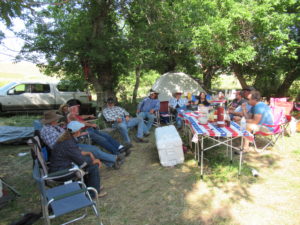 Perhaps the best (and least expected) part of the trip was the people. Both the TX crew and our fellow guests were wonderful! Everyone worked hard, joked, teased, laughed, helped, and had a good time. There is something about spending hours working hard together, backing each other up, followed by relaxing, eating and laughing together, that helps develop a close-knit team.
Perhaps the best (and least expected) part of the trip was the people. Both the TX crew and our fellow guests were wonderful! Everyone worked hard, joked, teased, laughed, helped, and had a good time. There is something about spending hours working hard together, backing each other up, followed by relaxing, eating and laughing together, that helps develop a close-knit team.
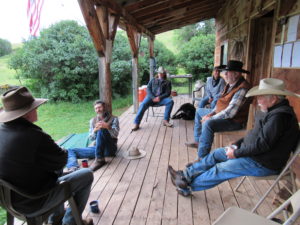 Thinking back across the week, several humorous moments stand out… mostly having to do with my lack of understanding.
Thinking back across the week, several humorous moments stand out… mostly having to do with my lack of understanding.
For example, there was the long, hard, dusty day we brought cattle back from Deadman. We were pushing the cattle along a trail with a poorly maintained barb-wire fence on the right side. Several cows kept making a run to escape through holes in the fence and I was working hard to keep them going down the trail with the rest of the herd. Suddenly two cows and a calf made a run for a spot where the fence was lying on the ground. I pushed my horse into a lope, trying to reach the hole in time to turn them back, but they made it through the fence. I tried to pursue them, but my horse hesitated at crossing the fence. When I pushed him, he tentatively started to cross the low wire, then pulled back, momentarily snagging a front shoe on a wire. By the time I got my horse settled and extracted from the fence wire, the cows were long gone into the brush along the creek.
Frustrated, I glanced toward Hip for direction. “Why don’t you ride ahead to the next gate and make sure the cows go through the gate?” Hip suggested.
I rode ahead with Des following. About 100 yards down the trail, we came to an unobstructed gap at a fence corner. “Is this the gate Hip was talking about?” I asked Des.
“Yeah, just make sure the cows don’t wander off down that trail to the left,” Des responded.
“Do you mean we’re pushing the cows through a gate into the very pasture I’ve been working so hard to keep them out of?”
“Yep!” Des quipped, with a wry grin and a nod.
“Dang! I was working my butt off keeping them on this side of that fence!” I exclaimed.
“Yes, you were!” laughed Des.
Later that evening, after dinner, I told Hip, “I’m confident I gave you 110% effort all day today. However, I only had about 40% understanding what I was supposed to be doing. Which means I was only about 44% effective and about 66% counterproductive.”
“That’s great!” Hip responded, “Joe, if I had a half-dozen riders all 44% effective, we could get a lot done in a day.”
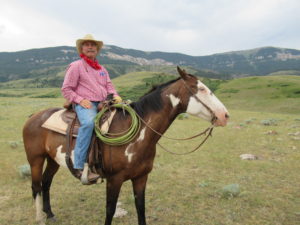 I fell asleep pondering these events. As I drifted off to sleep, Ray Hunt’s words regarding horsemanship came to mind, “Set it up and let it happen.” Ray’s approach to horsemanship centered around setting the horse up for success, then letting him figure it out for himself.
I fell asleep pondering these events. As I drifted off to sleep, Ray Hunt’s words regarding horsemanship came to mind, “Set it up and let it happen.” Ray’s approach to horsemanship centered around setting the horse up for success, then letting him figure it out for himself.
As the week progressed, I realized Hip and Des seem to follow this model in pretty much everything they do. Hip gave us only a bare minimum of verbal direction on what we were to do each day. Then he left us to figure out the rest through a combination of watching and doing.
The best part of this approach is the freedom allowed each of us to try new things.
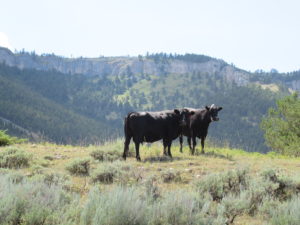 When I set out to gather a couple of cows spotted on a mountaintop, nobody called me back. Nobody told me I would never be able to gather those cows and get them back in the herd on my own. I was allowed to explore, try, and figure things out for myself. As a result, I grew confident trying new things and riding rough trails… trusting my horse to go where I asked then get me safely back.
When I set out to gather a couple of cows spotted on a mountaintop, nobody called me back. Nobody told me I would never be able to gather those cows and get them back in the herd on my own. I was allowed to explore, try, and figure things out for myself. As a result, I grew confident trying new things and riding rough trails… trusting my horse to go where I asked then get me safely back.
Sometimes it worked out as planned and sometimes it didn’t. Either way, I had fun trying!
Isn’t that similar to the approach God uses in directing our steps? He tends to give us a bare minimum of direction, then grant us the freedom to enjoy figuring out the specifics for ourselves.
When God told Abraham to leave his home in Ur of the Chaldeans and travel to the land of Canaan, He didn’t provide a whole lot of specifics. Abraham spent the rest of his life wandering around Canaan, trying to figure what he was to do next, while trusting God to fulfill His promises and provide what was needed. Sometimes Abraham made wise choices and sometimes he didn’t. Either way, he gained a deeper relationship with God based on a higher level of trust.
When God told Moses to go ask Pharaoh to let the Israelites go, He did not provide many specifics. Moses had to act in faith with a bare minimum of understanding of the plan. Then God provided further direction as needed. By the end of his life, Moses had led the people of Israel out of Egypt, through 40 years of living in the desert, and had gained a much deeper relationship with God and a greater reliance on God’s trustworthiness.
I see God working in our lives today in much the same manner. God tends to give us a bare minimum of details in asking us to step out in faith. Many times the details are left for us to figure out for ourselves. Sometimes we make wise choices and sometimes we don’t. Either way, we can trust God to work through our meager faith to work His will and purpose in our lives while drawing us into deeper relationship with Himself.
